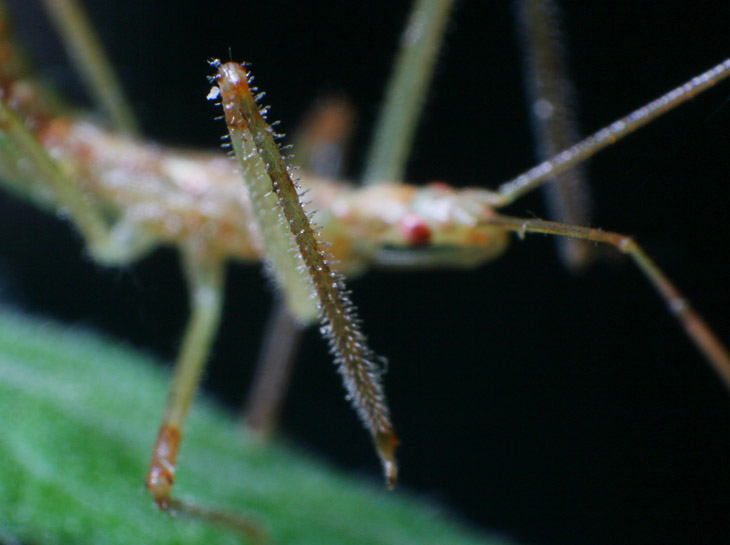
While looking up details for an earlier post I came across a curious trait of this particular species of assassin bug, and decided I’d like to try and get shots of it in action. I have been too lucky lately, and thought this luck might hold, but alas…
Pale green assassin bugs (Zelus luridus,) seen in several recent posts, are spindly little insects usually measuring less than 20mm in body length as adults, so roughly twice as long as a housefly, and on first glance they might give the impression of being spiders. You’d have to look really closely to see that their legs, especially their forelegs, are covered with short hairs, and even closer to find that they glisten. This glistening is due to a secretion of the bug, and is apparently sticky to some degree; my source of this information likened it to the stalks of a sundew plant, seen below, which snares arthropod victims to digest as a source of food.
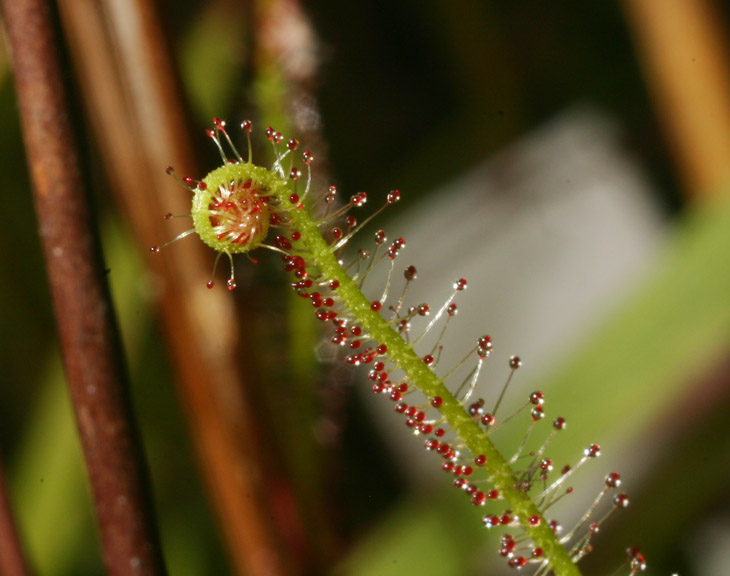
 A closer look at the insect’s leg is seen at right – this is one that I captured and kept in the same terrarium with the magnolia green jumping spiders until I could arrange some particular photos. It would have been nice to get video of one capturing its food, but extremely difficult; being there at just the right moment, with adequate lighting and the camera focused, while the assassin snagged some prey in unobscured view, would be demanding to say the least. In fact, despite finding this species all over the place for the past several years, I think I’ve seen it with prey maybe twice – one of those is seen here.
A closer look at the insect’s leg is seen at right – this is one that I captured and kept in the same terrarium with the magnolia green jumping spiders until I could arrange some particular photos. It would have been nice to get video of one capturing its food, but extremely difficult; being there at just the right moment, with adequate lighting and the camera focused, while the assassin snagged some prey in unobscured view, would be demanding to say the least. In fact, despite finding this species all over the place for the past several years, I think I’ve seen it with prey maybe twice – one of those is seen here.
Even while provided with a variety of food insects in an enclosed area, I never saw the assassin with a capture at all, so I did these detail shots yesterday and then released it. Now, this was a nice set of controlled conditions, with a captive subject that was never more than 15cm from a food source (usually quite a selection of them) – imagine doing something like stalking one of these in ‘the wild’ and hoping to snag action shots as it successfully captured its prey. I imagine it’s an activity for those who find watching paint dry to be too hectic…
In contrast, the magnolia green jumping spiders (Lyssomanes viridis) have been surprisingly easy to work with, even while possessing the typical jumping spider behavior of wandering around frequently. I’ve learned that this species is a little more sedate, tending to lie in wait and ambush prey that comes close, but I’ve seen several captures, including as I sat and waited for the assassin to partake of the same collection of food insects that I most recently introduced into the terrarium. Even more interestingly, I’ve spotted them with prey in the yard twice recently, one of those just yesterday before I even got the assassin shots above.

The gardenia bushes, planted just last year as we moved in, have proven to be a favorite for several spider species, but the magnolia jumpers really like hanging out on the undersides of the leaves, and that’s where I spotted and photographed this one. This image is actually inverted; I shot it upside-down looking up at the underside of the leaf, which explains all the debris on the leaf, since this one was close enough to the ground to catch all the splatter from the rain (there’s no grass in that area at all, just bare ground.) The shooting position was so awkward I didn’t even realize the spider had prey until I unloaded the memory card.
And, upon writing this, I realized I hadn’t gotten one of the shots I’ve been thinking of for weeks, and (yes, late at night) decided to see if I could snag a quick one while I was on-topic. It’s raining out, so you can see my (pointless and possibly psychotic) dedication to the blog. The subject seen above was still in place, but that debris messed with my plans too much, so I found another after a brief search, this one on the struggling remnants of The Girlfriend’s lilies (same one seen here.)
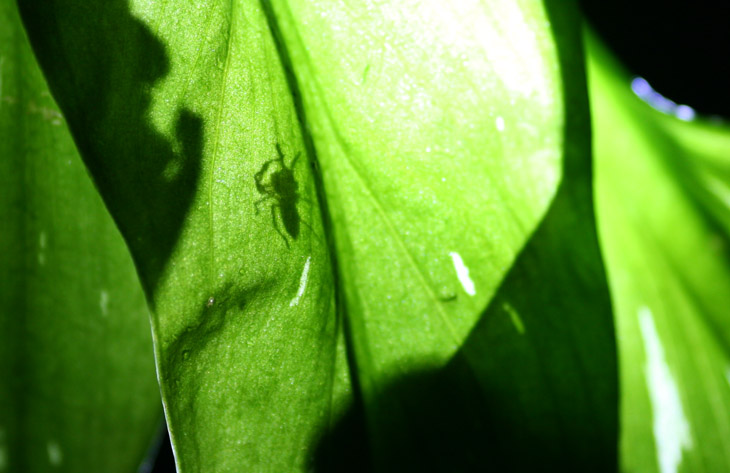
This is actually the easiest way to find the littler buggers: shine a flashlight up at the underside of the leaves. It’s best at night of course, but still works during the day, and this one was done with my headlamp propped up underneath the plant, allowing me a decent shutter speed that wouldn’t even have required the tripod – since I was only shooting a shadow, depth wasn’t needed and f4 was adequate to pull off 1/100 second at ISO 200. I had to time it between the vibrations of the raindrops, though.
The jumpers have been a lot more cooperative than the assassins (there’s a sentence that desperately needs its context,) so we’ll continue with them. During one session, the spider turned away from me and ruined my chance at getting those googly eyes in motion, but presented another opportunity: seeing the eyes from the side, through the exoskeleton.
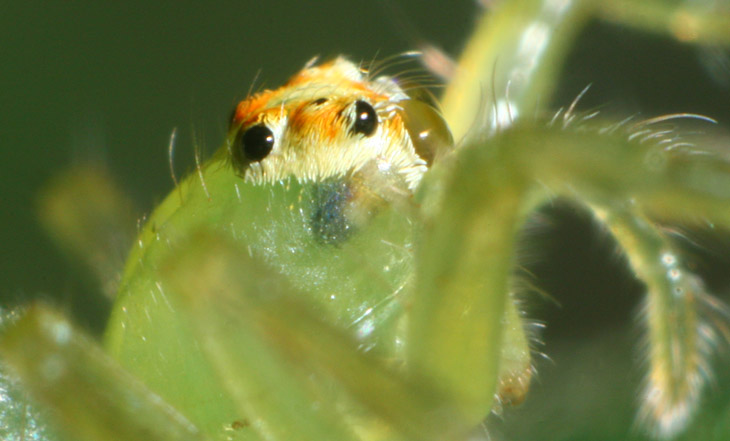
Don’t ask me what purpose that strawberry-blonde haircut serves, but beneath it, we can see a tan and a dark patch joined; these are actually the eye of the spider, which moves internally and isn’t always visible from this vantage. I’m going to rashly assume that the spider (or this eye, anyway) is looking up and to the left, pressing its eye against the side of the cephalothorax right in front of us. Yes, I know this is a weird thing to see; you don’t come here for latté and kittycats.
And one last one, because.
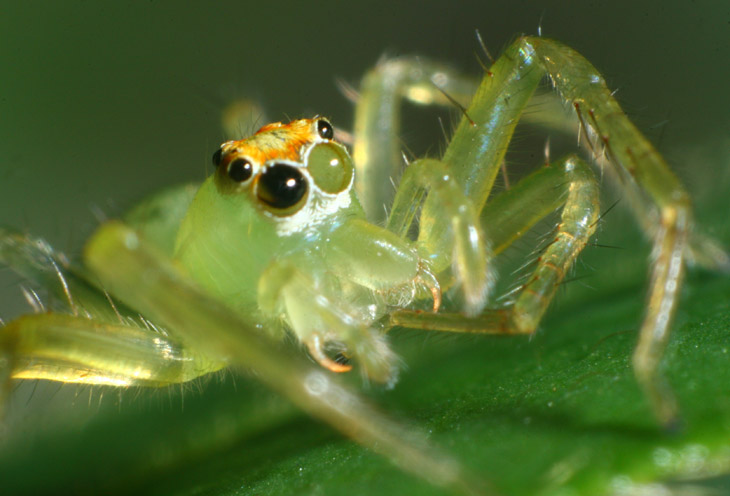
As threatening as this looks, it’s not anything even remotely aggressive, but simply the spider moving those fangs out of the way to clean a leg in its mouth, and I can’t even estimate how small those really are, since the entire spider is about 5mm in body length – safe to say you aren’t likely to feel anything even if it did try to bite. This, by the way, is the first spider species I’ve seen that did not have reddish-brown chelicerae. Even the two centipede species that I’ve gotten detailed shots of had modeled the same color.
But yeah, only six eyes – not every spider has eight.




















































